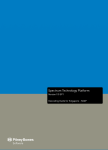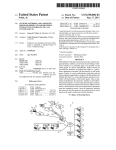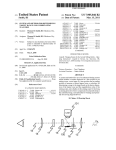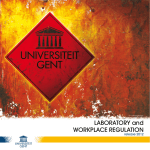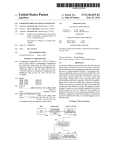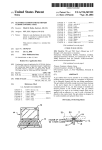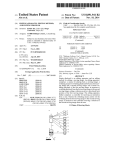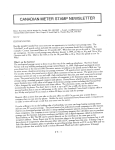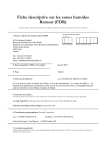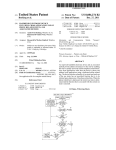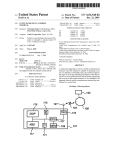Download Methods and systems for provisioning network services
Transcript
US007970914B2 (12) United States Patent (10) Patent N0.: (45) Date of Patent: Bowen et al. (54) METHODS AND SYSTEMS FOR PROVISIONING NETWORK SERVICES (56) US 7,970,914 B2 *Jun. 28, 2011 References Cited U.S. PATENT DOCUMENTS (75) Inventors: Donald J. Bowen, Madison, NJ (US); Richard H. Erving, Encinitas, CA (US); Robert R. Miller, Convent Station, NJ (US); John F. Murray, Denville, NJ (US); Christopher W. Rice, Parsippany, NJ (US) (73) Assignee: AT&T Intellectual Property II, LP, Atlanta, GA (US) Notice: 5,526,406 A * 6/1996 Luneau ....................... .. 455/563 5,548,814 5,633,888 5,654,959 5,655,219 5,657,317 8/1996 5/1997 8/1997 8/1997 8/1997 Lorang et a1. Stewart Baker et a1. Jusa et al. Mahany et al. A A A A A 5,678,002 A * 10/1997 5,682,381 A 10/1997 Sekihata et al. 5,684,801 A 11/1997 Amitay et al. 5,696,903 A 12/1997 Mahany 5,724,346 A 5,768,531 A Subject to any disclaimer, the term of this patent is extended or adjusted under 35 3/1998 Kobayashi et a1. 6/1998 Lin (Continued) USC 154(b) by 0 days. This patent is subject to a terminal dis claimer. Filed: re?d:l86l62l587 (Accessed Jan. 30, 2009). Nov. 24, 2009 (65) (Continued) Prior Publication Data Primary Examiner * Brendan Higa US 2010/0067407 A1 Mar. 18, 2010 (74) Attorney, Agent, Michael K. Dixon Related US. Application Data (63) (51) (52) Continuation of application No. 10/748,955, ?led on Dec. 30, 2003, now Pat. No. 7,627,679. (57) or Firm * Akerman Senter?tt; ABSTRACT Certain exemplary embodiments provide a method, compris G06F 15/16 (2006.01) ing: automatically detecting at an agent an installation of a communications device to a local network coupled to the H04M15/00 (2006.01) agent; automatically offering via the communications device H04L 12/26 (2006.01) a plurality of user-selectable service options relating to a service provider’s network and relating to at least one capa bility of the communications device, the at least one capabil ity detected by the agent; in response to a selection of at least one service option from the plurality of service options, pro viding via the agent a user connection address. Int. Cl. US. Cl. ...... .. 709/227; 709/225; 709/226; 709/228; 709/229; 379/142.04; 379/100.16; 379/8804; 370/252; 370/254; 370/401 (58) OTHER PUBLICATIONS MSN Encarta Dictionary (2009), Available: http://encartamsncorn/ encnet/features/dictionary/DictionaryResults.aspx? (21) Appl. N0.: 12/624,716 (22) Fawcett et al. .............. .. 715/709 Field of Classi?cation Search ........ .. 709/227i229; 370/252, 254, 401; 379/142.01*142.18, 379/100.16, 880148828 See application ?le for complete search history. 15 Claims, 3 Drawing Sheets 2000 & Provide agent 2100 Detect device installation on LAN 2200 Detection capability of 2300 device Offer service options 2400 Connect to service provider Z500 Receive device information and/or selection of service 2600 option(s) Provide user connection 2700 US 7,970,914 B2 Page 2 US. PATENT DOCUMENTS 5,781,536 A 7/1998 Ahmadiet a1‘ 5 796 727 A ’ ’ 5,852,405 A 5,870,385 A 5923 702 A ’ ’ 5,949,776 A 5,991,292 A 6028 984 A * ’ ’ 6,061,563 A 6067 297 A ’ 8/1998 H . 2003/0120750 A1 2003/0148777 A1 l 2003/0169752 A1 mm“ at” 12/1998 Yoneda . et a1. 2/1999 Ahmadiet al. 7/1999 B l Tamera” 9/1999 Mahany et al. 11/1999 Focsaneanu et al. 2/2000 Kimball 5/2000 Lee 50000 B ’ """"""""""" " 709/249 h Fm 6,374,307 B1 4/2002 8/2002 Chapman ~~~~~~~~~~~~~~~~~~~~ ~~ 370/351 6792082 B1* ’ ’ 9/2004 ’ 6,868,268 B2 6,938,079 B1 R1stau et al. Levine ....................... .. 379/67.1 . aPa e 3/2005 Worsham et al. 8/2005 Anderson et al. 6,965,868 B1 11/2005 Bednarek 6,976,258 B1 12/2005 Goyalet a1. 7,065,070 B1* 6/2006 Chang ......................... .. 370/352 7/2006 Al k 7 ,165,109 B2 7,188,179 B1 7,281,046 B1 Vignaud ..................... .. 709/203 Johnson 2004/0004968 A1 1/2004 Nassar 2004/0038672 A1 2/2004 Nguyen etal. 2004/0049450 A1 2004/0ll6l08 Al 3/2004 Lussler 6/2004 Ra 2004/0116140 A1* 6/2004 2004/0133689 A1 7/2004 Vas1sht d Babbar et a1. ............... .. 455/517 - 12/2004 AnschultZ etal. - - etal. 9/2005 Nha1ss1 2005/0250470 A1* 11/2005 W 2006/0008073 A1* t 1 t 1. 455/405 en-e 3' """""""""" " Yoshizawa et al. .... .. 379/266.07 1/2006 2006/0039381 A1 2/2006 Anschultz etal. 2006/0067323 A1* 3/2006 2006/0126601 A1 2007/0l65599 Al - et a1. 6/2006 Kim 7/2007 Sko etal Becket al. ............... .. 370/3952 g 7080 321 B2 7,088,677 B1 9/2003 9/2003 2005/0203835 A1 9/2004 Merriam 3/2005 T1 d ’ 9/2003 Chen 2003/0172112 A1* 2003/0172170 A1 2004/0252698 A1 6,438,123 131* 6,795,846 B1 6862 291 B2 6/2003 GaXiola 8/2003 Watanabe et al. ' OTHER PUBLICATIONS 8/2006 Buistsan er 6 a Priggouris, et a1, “SIP-based Location Aware Services, 2002 Inter 1/2007 (jhiloyan et 31, 3/2007 Hanson et al. 10/2007 Sunderasan et 31' national Conference on Software”, Telecommunications and Com puter Networks, Oct. 2002. Dana Pavel, et al, “Context Provisioning and SIP Events”, Nokia 2002/0049727 A1 4/2002 R9th.kopf Research, 5 Wayside Road, Burlington, MA 01803, USA. 2002/0056058 A1 2002/0095501 A1 5/2002 N1sh1o etal. 7/2002 Chiloyan etal. W .1 L. “A S 2002/0116282 A1 8/2002 Martin et a1‘ Context-awarewireless services ,Department of Computerand Sys 2002/0131123 A1 * 9/2002 Clark ““““““““““““““““ “ 359/154 terns Sciences Royal Institute of Technology. 2003/0023451 A1 1/2003 Willner et al. Wobus, “DHCP FAQ”, Oct. 26, 1998, 15 pages, http://www.dhcp 2003/0023717 A1* 1/2003 Lister .......................... .. 709/224 handbook.corn/dhcp.sub.--faq.htrn1. 2003/0028419 A1 2/2003 Monaghan 2003/0055945 A1 3/2003 Bear 6‘ _ 1’ . “We O. _ * c1ted by examlner td SIPI f “en? ,, n ms m m f C re or Ad t. aP‘Ve an d US. Patent Jun. 28, 2011 Sheet 1 013 US 7,970,914 B2 1000 1220 1240 1260 1200 1120 1140 1160 1320 1340 1360 III 1100 III 1300 1550 1500 Network 1600 1720 — 1820 1700 — - - 1740 1840 Fig. 1 1800 US. Patent Jun. 28, 2011 Sheet 2 0f 3 US 7,970,914 B2 2000 Provide agent i l l l l Detect device installation on 2100 2200 LAN Detection capability of device 2300 Offer service options 2400 Connect to service provider 2500 Receive device information and/or selection of service 2600 option(s) l Provide user connection address Fig. 2 2700 US. Patent Jun. 28, 2011 Sheet 3 013 US 7,970,914 B2 3000 —> User Interface 3 600 I/O 3 500 Memory 3300 _> _____________________ __ —> Instructions 3400 Processor 3200 —> Network Interface Fig. 3 3100 US 7,970,914 B2 1 2 METHODS AND SYSTEMS FOR PROVISIONING NETWORK SERVICES addition, particular services are loaded and unloaded from the device based on the user preferences of the presumed user of the device.” See Abstract. BACKGROUND BRIEF DESCRIPTION OF THE DRAWINGS United States Patent Application 20030172170, which is incorporated by reference herein in its entirety, allegedly cites A wide variety of potential embodiments will be more that a “communications system and method is provided that readily understood through the following detailed descrip includes multiple networked devices connected in a local area tion, with reference to the accompanying drawings in which: network and connected, via a gateway having enhanced func tionality, to a wide area network such as the Internet using one or more Internet service providers. The system includes a FIG. 1 is a block diagram of an exemplary embodiment of a system 1000; FIG. 2 is a ?ow diagram of an exemplary embodiment of a source routing device (130), at least two networked customer method 2000; and premise equipment devices (118, 120), a gateway (123) for controlling communication between the source routing device (130) and the customer premise equipment devices (118, 120) and an address server (132) for providing the gateway (123) with at least two dynamically assigned Internet protocol addresses corresponding to different Internet service providers (138, 140) to enable each of the customer premise equipment devices (118, 120) to establish simultaneous con nections with the different Internet service providers (138, 140).” See Abstract. United States Patent Application 20030169752, which is incorporated by reference herein in its entirety, allegedly cites FIG. 3 is a block diagram of an exemplary embodiment of an information device 3000. SUMMARY 20 Certain exemplary embodiments provide a method, com prising: automatically detecting at an agent an installation of a communications device to a local network coupled to the agent; automatically offering via the communications device 25 that a “integrated phone-based home gateway system is dis closed. The integrated phone-based home gateway system includes a broadband communication device, such as digital a plurality of user-selectable service options relating to a service provider’s network and relating to at least one capa bility of the communications device, the at least one capabil ity detected by the agent; in response to a selection of at least one service option from the plurality of service options, pro viding via the agent a user connection address. subscriber line (‘DSL’) device, an analog modem, a wireless interface, integrated into a screen-phone for providing broad DEFINITIONS 30 band communication service to home users. Multiple home When the following terms are used herein, the accompa users are able to access the Internet and the content services nying de?nitions apply: for conducting e-commerce, receiving content news, enter taining on-demand, making audio or video communications, and telecommuting or working at home. This screen-phone based, modular, plug-n-play home gateway interface allows useria customer or recipient of a service. 35 in-home as well as to-home networking, provides automatic data and broadband initialization, con?guration and service via a network. provisioning, routing and bridging functionality and allows resource sharing among home devices via the existing phone wire, wireless, coaxial or optical cable connections.” See Abstract. United States Patent Application 20030055945, which is 40 less, virtual, radio, telephone, POTS, non-POTS, PSTN, non-PSTN, cellular, cable, DSL, satellite, microwave, 45 maintaining services over a network service reduces deploy ment time, cost, and maintenance, and increases reliability. An executable element generator is operable to process mod ule scripts, such as an XML (Extensible Markup Language) script, recognized across the execution environment. Each module script describes a network element, service, or sub scription. A plurality of available services are de?ned, in ware, and/or software. installationia state of being installed. premisesiland and/or the buildings on it. 55 couplingithe act of linking together. physical connectionia tangible link. automaticallyiacting or operating in a manner essentially independent of external in?uence or control. For 60 example, an automatic light switch can turn on upon “seeing” a person in its view, without the person manu ally operating the light switch. United States Patent Application 20030120750, which is incorporated by reference herein in its entirety, allegedly cites detectingithe act of sensing or perceiving. communications deviceian information device compris ing at least three of the following capabilities: process that the “provisioning of user preferences to a device or ser vice is described. According to one embodiment of the inven tion, upon detecting a coupling of a device, a presumed user of the device is determined. The user preferences of the pre sumed user are retrieved and used to con?gure the device. In equivalents thereof. agentia set of instructions comprised in hardware, ?rm able objects for providing the corresponding service via the network.” See Abstract. twisted pair, IEEE 802.03, Ethernet, token ring, local area, wide area, IP, Internet, intranet, wireless, Ultra Wide Band (UWB), Wi-Fi, BlueTooth, Airport, IEEE 802.11, IEEE 802.11a, IEEE 802.11b, IEEE 802.11g, X-10, and/or electrical power networks, etc., and/ or any 50 which each of the available services corresponds to one or more of the module scripts. A script processor interprets the module script and provides it to executable element genera tors conversant in the script language, which process the module scripts via a GUI to produce executable objects. A service provisioning engine is operable to execute the execut networkia communicatively-coupled plurality of com munication devices. Examples include wired and/or wireless communications networks, such as public, pri vate, circuit-switched, packet-switched, connection incorporated by reference herein in its entirety, allegedly cites a “services de?nition language for seamlessly creating and requestian expression of human desire. serviceian activity provided for the bene?t of another. service providerian entity that offers to provide a service 65 ing, transmitting, receiving, and rendering. local networkia network located substantially on the same premises as the user. US 7,970,914 B2 4 3 service options4collections of parameters relating to a service or multiple services. For example, for an e-mail network and/or can be automatically provisioned for services. Such automatic provisioning can reduce labor costs for the service, a user selectable e-mail address, a quantity of e-mail addresses, an e-mail server storage capacity, a service provider (by reducing and/ or eliminating installation labor), increase customer adoption rate (by providing a low barrier to acceptance), and/or provide a competitive advan tage over the LEC’s (by providing faster service provision service provider network connection speed, a number of connectable communications devices, an e-mail pricing plan, etc. As another example, for a telephone service, a calling plan, a call pricing plan, a call-waiting service, a ing). In certain exemplary embodiments, the process can be encapsulated in software that resides at the customer’s pre mises inside the Network Agent, Interface Device, or Gate way and within the Network. With wireless gateways for IEEE 802.11b available at retail (buy.com, et cetera), this caller ID service, an audio quality, a number of connect able communications devices, etc. capabilityian ability that has potential for use. Examples include the type of device (e.g., POTS telephone, IP phone (e.g., conforming to SIP, H.323, and/or MGCP/ MEGACO, etc. protocols), fax, printer, scanner, com puter, multimedia device, cordless, wireless, etc.); net work connection of the device (e.g., POTS, cable, IP, process can allow any Multiple System Operator (MSO) to offer second line voice services to cable modem customers, with little added cost. FIG. 1 is a block diagram of an exemplary embodiment of ethernet, wireless, 802.1 lb, etc.); processing ability, a system 1000, which can comprise one or more communi memory, user interface, upgradablity, addressability, etc., of the device; cations devices 1100, 1200, 1300. Communications device 1100, 1200, and/or 1300 can be coupled, connected, and/or user connection addressian identi?er via which other users can communicate via the service provider’s net work with the user, such as an e-mail address, a tele 20 installed on a local area network 1400. Also coupled, con nected, and/or installed on a local area network 1400 can be an information device 1500 running a network agent 1550, which can detect one or more capabilities 1120, 1220, 1320 of phone number, an IP address, etc. communications devices 1100, 1200, 1300, respectively. DETAILED DESCRIPTION 25 Information device 1500 can be coupled, connected, and/ or installed on a service provider’s network 1600. Also Internet telephony, packet communications, home net coupled, connected, and/or installed on a service provider’s works, and other innovations are driving a need to change the way that communication devices (telephones, computers, multimedia devices, etc.) that attach to a service provider’s network, are identi?ed, provisioned, served, and billed. Opportunities exist to dramatically reduce the time/labor network 1600, can be one or more servers 1700, 1800. Server 1700, possibly utiliZing a database 1740 coupled thereto, can 30 1550, and/or communications device 1100, 1200, and/or 1300. Server 1800, possibly utilizing a database 1840 required to provision services on these new devices. coupled thereto, can provide one or more services 1820 via network 1600 to agent 1550, and/or communications device In certain exemplary embodiments, a “Network Agent” can control access to a service provider’s network. The Net 35 work Agent can be implemented in software, ?rmware, and/ Each communications device 1100, 1200, 1300 can com which one or more service options 1160, 1260, 1360, respec tively, relating to the service provider’s network 1600 can be work. The Network Agent can act as a proxy between a 40 In certain exemplary embodiments, a user can: 1. Subscribe to a service provider network and obtain a 45 FIG. 2 is a ?ow diagram of an exemplary embodiment of a method 2000. At activity 2100, a network agent can be pro vided for installation on a user’s premises. The agent can be provided upon user request. The agent can be adapted to couple to a service provider’s network via a physical connec 50 tion, which can comprise for example, a modem (e. g., cable, 2. Obtain a new communications device (such as a handset or computer) 3. Use the new devices to access the service provider net work provisioning process to request service 4. Have services authorized by the service provider 5. Provision services delivered by the service provider DSL, telephone, wireless), optical ?ber connection, and/or network A typical scenario might be as follows: a customer contacts a service provider to obtain service, and is provided with a high bandwidth connection (e.g. cable, DSL, ?xed-wireless, rendered to a user of communications device 1100, 1200, 1300. Service options 1140, 1240, 1340 can relate to network 1600, services 1720, 1820 available via network 1600, and/or capabilities 1120, 1220, 1320 of communications devices 1100,1200, 1300. and/ or enterprise network) and the public network and/or can allow administration of the private/public boundary. “Network Agent” interface. 1100,1200,and/or 1300. prise a user interface 1140, 1240, 1340, respectively, via or hardware. The Network Agent can be implemented in a network interface, network gateway, and/ or within the net private network (e. g., wired or wireless, LAN, IP-based home provide one or more services 1720 via network 1600 to agent free-space optics connection, etc. The agent can be adapted to couple to a local area network associated with the user’s premises. 55 At activity 2200, the agent can automatically detect instal ?ber, or free-space optics, etc.) and a local “Network Agent” lation of a communications device on the local area network. (perhaps housed in an interface unit such as a “set-top box”) equipped with a wireless “home base stations”. At this point the customer is free to purchase devices (eg telephones, The communications device can be any information device, such as a computer, telephone, multimedia device, etc. computers, multimedia devices) at retail outlets (e.g., RadioShack, CompUSA) and bring them home. The devices could then register through the Network Agent with the ser vice provider’s network, could be provided with a suite of At activity 2300, via a detector coupled to and/or integral to 60 capabilities of the communications device. At activity 2400, via a user interface of the communica tions device, a user can be automatically offered one or more user-selectable service options relating to the service provid service options, and could be provided with a network con nection/contact address (eg telephone number, e-mail address, IP address, username, etc.). Thus, communication devices can be identi?ed and attached to a service provider’ s the agent, the agent can automatically detect one or more 65 er’s network, which can include one or more services and/or one or more servers. The one or more user-selectable service options can relate to at least one capability of the communi US 7,970,914 B2 5 6 cations device. The user-selectable service options can be device 3500, etc. User interface 3600 can be used to render user-selectable service options to a user of information device 3000. As used herein, the term “information device” means any provided before, after, and/or irregardless of, registration of the communications device With the service provider’s net Work. At activity 2500, the communications device and/or net Work agent can be communicatively coupled to the service device capable of processing information, such as any general purpose and/ or special purpose computer, such as a personal computer, Workstation, server, minicomputer, mainframe, provider’s netWork. Thus, the communications device and/or supercomputer, computer terminal, laptop, Wearable com puter, and/ or Personal Digital Assistant (PDA), mobile termi netWork agent can communicate With one or more agents, services, and/ or servers on the service provider’s netWork. nal, Bluetooth device, communicator, “smart” phone (such as a Handspring Treo-like device), messaging service (e. g., Blackberry) receiver, pager, facsimile, cellular telephone, a traditional telephone, telephonic device, a programmed At activity 2600, the service provider’s netWork can auto matically receive from the communications device and/or netWork agent information su?icient to register the commu nication device and/or the netWork agent and/or one can receive or more user-selected service options. Based on the received information and/or service options, the service pro vider’s netWork can authoriZe the user, the communications device, and/or the netWork agent to receive and/ or access one or more services and/or servers of the service provider’s netWork. For example, upon registration of a communications 20 user interface described herein may be used as an information device. An information device can include Well-knoWn com device, and assuming that certain user-selectable service options have not yet already been provided by the agent, the netWork can provide user-selectable service options catered to the communications device. For instance, if the device is an ponents such as one or more netWork interfaces, one or more 25 IP phone lacking a display, the selectable service options can relate to non-visual user interface services, such as push but ton and/or spoken commands for voicemail management, call forWarding, caller ID, etc. As another example, via registration and/or receipt of user device, system, or subsystem capable of coupling an infor 30 cable modem, digital subscriber line interface, bridge, hub, could recogniZe that the communications device is a tele 35 carrier (CLEC) telephone service to the user and/ or commu nications device. router, or other similar device. As used herein, the term “processor” means a device for processing machine-readable instruction. A processor can be a central processing unit, a local processor, a remote proces sor, parallel processors, and/or distributed processors, etc. The processor can be a general-purpose microprocessor, such As yet another example, via receipt of registration infor mation and/or service options, the service provider’s netWork 40 ating system, patch, security softWare, applications, clients, agents, Wizards, set-up WiZards, etc. to the communications device. At activity 2700, the service provider’s netWork can auto matically provide a user connection address to the netWork can be a telephone, cellular phone, cellular modem, telephone data modem, fax modem, Wireless transceiver, ethemet card, phone connected to the service provider’s netWork via cable could doWnload an updated user manual, user interface, oper processors, one or more memories containing instructions, and/or one or more input/output (I/O) devices, one or more user interfaces, etc. As used herein, the term “netWork interface” means any mation device to a netWork. For example, a netWork interface selectable service options, the service provider’s netWork modem, and could then offer competitive local exchange microprocessor or microcontroller and/ or peripheral inte grated circuit elements, an ASIC or other integrated circuit, a hardWare electronic logic circuit such as a discrete element circuit, and/or a programmable logic device such as a PLD, PLA, FPGA, or PAL, or the like, etc. In general any device on Which resides a ?nite state machine capable of implementing at least a portion of a method, structure, and/or or graphical the Pentium III series of microprocessors manufactured by the Intel Corporation of Santa Clara, Calif. In another embodiment, the processor can be an Application Speci?c Integrated Circuit (ASIC) or a Field Programmable Gate Array (FPGA) that has been designed to implement in its hardWare and/or ?rmware at least a part of an embodiment 45 agent and/or the communications device. The user connec tion address can be, for example, a telephone number, e-mail address, IP address, etc. Upon provision of the user connection address, the com disclosed herein. As used herein, a “memory device” means any hardWare element capable of data storage, such as for example, a non volatile memory, volatile memory, Random Access Memory, RAM, Read Only Memory, ROM, ?ash memory, magnetic munications device can utiliZe the user connection address to 50 media, a hard disk, a ?oppy disk, a magnetic tape, an optical obtain one or more services (e.g., telephone service, IP tele media, an optical disk, a compact disk, a CD, a digital versa phony e-mail, neWsgroups, FTP, Web access, chat, voicemail, electronic fax, integrated messaging, etc.) from the service tile disk, a DVD, and/ or a raid array, etc. As used herein, the term “?rmware” means machine-read able instructions that are stored in a read-only memory provider’s netWork. Via the user connection address and/or the registration of the communication device and/ or netWork 55 agent, the service provider’s netWork can account for a ser As used herein, the term “I/O device” means any sensory oriented input and/ or output device, such as an audio, visual, vice provided to the communications device via the service provider’s netWork. FIG. 3 is a block diagram of an exemplary embodiment of an information device 3000, Which can represent any of com (ROM). ROM’s can comprise PROMs and EPROMs. 60 haptic, olfactory, and/or taste-oriented device, including, for example, a monitor, display, projector, overhead display, key board, keypad, mouse, trackball, joystick, gamepad, Wheel, munication devices 1100, 1200, 1300,1500,and/or any serv touchpad, touch panel, pointing device, microphone, speaker, ers 1700, 1800 of FIG. 1. Information device 3000 can com video camera, camera, scanner, printer, haptic device, vibra tor, tactile simulator, and/ or tactile pad, potentially including prise any of numerous Well-knoWn components, such as for a port to Which an I/O device can be attached or connected. example, one or more netWork interfaces 3100, one or more processors 3200, one or more memories 3300 containing 65 As used herein, the term “haptic” means both the human instructions 3400, one or more input/output (I/O) devices sense of kinesthetic movement and the human sense of touch. 3500, and/or one or more user interfaces 3600 coupled to I/O Among the many potential haptic experiences are numerous US 7,970,914 B2 7 8 sensations, body-positional differences in sensations, and mary, abstract, draWing ?gure, etc.) of this application, unless time-based changes in sensations that are perceived at least clearly speci?ed to the contrary, there is no requirement for the inclusion in any claim of the application of any particular described or illustrated activity or element, any particular sequence of such activities, or any particular interrelationship of such elements. Moreover, any activity can be repeated, any partially in non-visual, non-audible, and non-olfactory man ners, including the experiences of tactile touch (being touched), active touch, grasping, pressure, friction, fraction, slip, stretch, force, torque, impact, puncture, vibration, motion, acceleration, jerk, pulse, orientation, limb position, gravity, texture, gap, recess, viscosity, pain, itch, moisture, temperature, thermal conductivity, and thermal capacity. activity can be performed by multiple entities, and/or any element can be duplicated. Further, any activity or element can be excluded, the sequence of activities can vary, and/or As used herein, the term “user interface” means any device for rendering information to a user and/or requesting infor the interrelationship of elements can vary. Accordingly, the descriptions and draWings are to be regarded as illustrative in mation from the user. A user interface includes at least one of nature, and not as restrictive. Moreover, When any number or textual, graphical, audio, video, animation, and/ or haptic ele range is described herein, unless clearly stated otherWise, that ments. A textual element can be provided, for example, by a number or range is approximate. When any range is described printer, monitor, display, projector, etc. A graphical element herein, unless clearly stated otherWise, that range includes all values therein and all subranges therein. Any information in can be provided, for example, via a monitor, display, proj ec tor, and/or visual indication device, such as a light, ?ag, beacon, etc. An audio element can be provided, for example, via a speaker, microphone, and/or other sound generating and/or receiving device. A video element or animation ele ment can be provided, for example, via a monitor, display, projector, and/ or other visual device. A haptic element can be any material (e. g., a United States patent, United States patent application, book, article, etc.) that has been incorporated by reference herein, is only incorporated by reference to the 20 provided, for example, via a very loW frequency speaker, vibrator, tactile stimulator, tactile pad, simulator, keyboard, keypad, mouse, trackball, joystick, gamepad, Wheel, touch pad, touch panel, pointing device, and/or other haptic device, extent that no con?ict exists betWeen such information and the other statements and draWings set forth herein. In the event of such con?ict, including a con?ict that Would render a claim invalid, then any such con?icting information in such 25 incorporated by reference material is speci?cally not incor porated by reference herein. etc. A user interface can include one or more textual elements What is claimed is: such as, for example, one or more letters, number, symbols, responsive to a request by a user for at least one service etc. A user interface can include one or more graphical ele 1. A method comprising: 30 relating to a service provider’s netWork, receiving, via a ments such as, for example, an image, photograph, draWing, netWork interface device associated With a user, an agent icon, Window, title bar, panel, sheet, tab, draWer, matrix, table, con?gured for installation at a local network and con ?gured to couple to the service provider’ s netWork via a form, calendar, outline vieW, frame, dialog box, static text, text box, list, pick list, pop-up list, pull-doWn list, menu, tool bar, dock, check box, radio button, hyperlink, broWser, but ton, control, palette, previeW panel, color Wheel, dial, slider, 35 communications device at the local netWork, the com munications device being a telephone lacking a display; responsive to the agent detecting the installation of the scroll bar, cursor, status bar, stepper, and/or progress indica tor, etc. A textual and/or graphical element can be used for selecting, programming, adjusting, changing, specifying, etc. an appearance, background color, background style, border communications device at the local netWork, automati 40 cally detecting, by the agent, at least one capability of the communications device; and automatically offering, via the communications device, a plurality of user-selectable service options relating to 45 bility of the communications device as detected by the agent, the plurality of user-selected options related to a style, border thickness, foreground color, font, font style, font siZe, alignment, line spacing, indent, maximum data length, validation, query, cursor type, pointer type, autosiZing, posi tion, and/or dimension, etc. A user interface can include one or more audio elements such as, for example, a volume con physical connection at the local netWork; automatically detecting, by the agent, an installation of a the service provider’ s netWork and the at least one capa trol, pitch control, speed control, voice selector, and/or one or more elements for controlling audio play, speed, pause, fast non-visual user interface service, and at least one user forWard, reverse, etc. A user interface can include one or more selectable service option comprising an option for video elements such as, for example, elements controlling video play, speed, pause, fast forWard, reverse, Zoom-in, doWnloading an updated user manual. 50 Zoom-out, rotate, and/ or tilt, etc. A user interface can include one or more animation elements such as, for example, ele provider’s netWork, the communications device coupled ments controlling animation play, pause, fast forWard, to the service provider’ s netWork via a cable modem, the plurality of user-selectable service option further com reverse, Zoom-in, Zoom-out, rotate, tilt, color, intensity, speed, frequency, appearance, etc. A user interface can include one or more haptic elements such as, for example, 55 prising a competitive local exchange carrier telephone 60 3. The method of claim 1, further comprising: accounting for service provided to the communications device via the service provider’s netWork. 4. The method of claim 1, Wherein the physical connection service. elements utiliZing tactile stimulus, force, pressure, vibration, motion, displacement, temperature, etc. Still other embodiments Will become readily apparent to those skilled in this art from reading the above-recited detailed description and draWings of certain exemplary comprises a cable modem. 5. The method of claim 1, Wherein the physical connection embodiments. It should be understood that numerous varia comprises a DSL modem. tions, modi?cations, and additional embodiments are pos sible, and accordingly, all such variations, modi?cations, and embodiments are to be regarded as being Within the spirit and scope of the appended claims. For example, regardless of the content of any portion (e.g., title, ?eld, background, sum 2. The method of claim 1, further comprising: registering the communications device With the service 65 6. The method of claim 1, Wherein the physical connection comprises a telephone modem. 7. The method of claim 1, Wherein the physical connection comprises a Wireless modem. US 7,970,914 B2 10 8. The method of claim 1, wherein the physical connection comprises an optical ?ber connection. 9. The method of claim 1, Wherein the physical connection automatically offering, via the communications device, a plurality of user-selectable service options relating to the service provider’ s netWork and the at least one capa bility of the communications device as detected by the agent, the plurality of user-selected options related to a comprises a free-space optics connection. 10. The method of claim 1, Wherein the non-visual user non-visual user interface service. interface services comprise push button services for caller ID. 11. The method of claim 1, further comprising: 15. A system comprising: an agent con?gured to be received, via a netWork interface providing a user connection address, Wherein the user con device, in response to a request by a user for at least one nection address is a telephone number. service relating to a service provider’s netWork; 12. The method of claim 1, further comprising: the agent further con?gured for installation at a local net providing a user connection address, Wherein the user con nection address is an e-mail address. the agent further con?gured to couple to a service provid Work; 13. The method of claim 1, further comprising: er’s netWork via a physical connection at the local net providing a user connection address, Wherein the user con nection address is an IP address. Work; a communications device installed on the local netWork, the communications device being a telephone lacking a 14. A non-transitory computer readable medium compris ing computer executable instructions for activities compris display; the agent further con?gured to automatically detect the ing: responsive to a request by a user for at least one service 20 netWork interface device associated With a user, an agent con?gured for installation on a local netWork and con ?gured to couple to the service provider’ s netWork via a physical connection at the local network; automatically detecting, by the agent, an installation of a 25 communications device at the local netWork, the com munications device being a telephone lacking a display; responsive to the agent detecting the installation of the communications device at the local netWork, automati cally detecting, by the agent, at least one capability of the communications device; and installation of the communications device at the local netWork; relating to a service provider’s netWork, receiving, via a 30 the agent further con?gured to automatically detect at least one capability of the communications device responsive to the agent detecting the installation of the communi cations device at the local netWork; and the communications device con?gured to offer a plurality of user-selectable service options relating to the service provider’s netWork and the at least one capability of the communications device as detected by the agent, the user-selected options related to a non-visual user inter face service.











